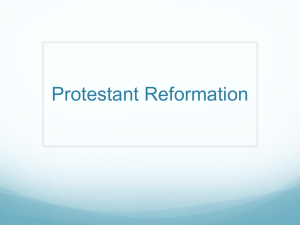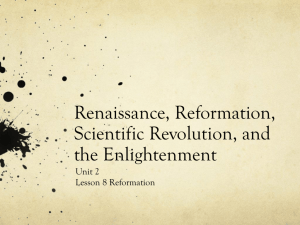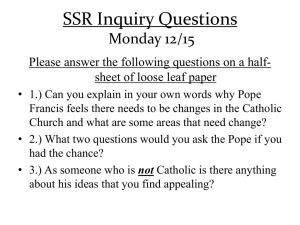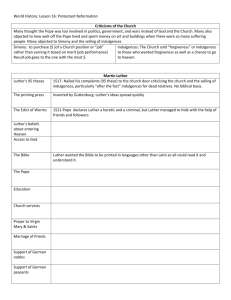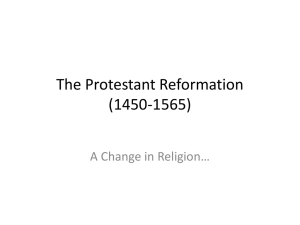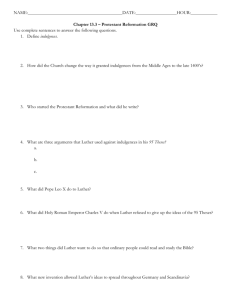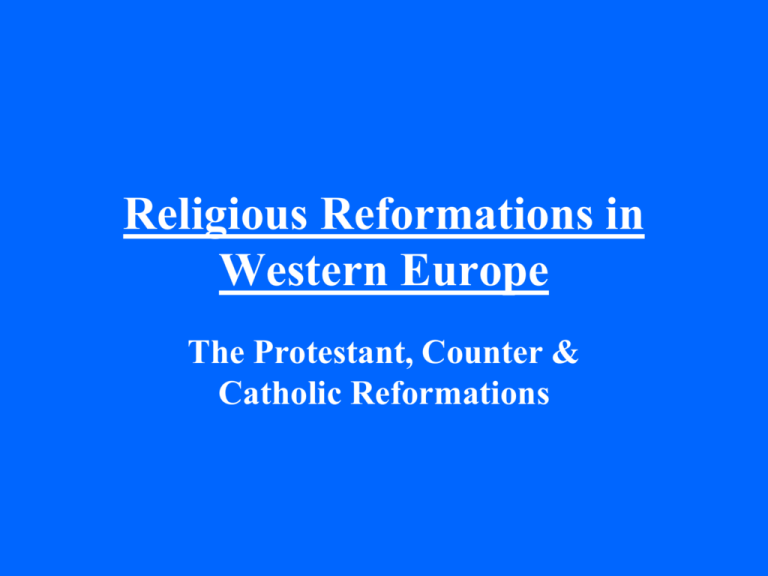
Religious Reformations in
Western Europe
The Protestant, Counter &
Catholic Reformations
Causes of the Protestant
Reformation
• Church Weaknesses: Corruption within Church
shattered Christian unity.
• Economic: Like other political rules, Popes and
other clergy maintained a lavish lifestyle (could
afford patronage of the arts).
• Political: Church became caught up in worldly
affairs. Popes competed with Italian princes for
political power.
Indulgences
• To finance projects intended to
beautify churches the Church
increased fees for services such
as marriages and baptisms.
• Some clergy promoted sale of
indulgences. An indulgence
was a lessening of the time a
soul would spend in purgatory.
• In the Middle Ages,
indulgences were granted for
good deeds, like fighting in the
Crusades. By the late 1400s,
indulgences could also be
obtained in exchange for money
gifts to the Church.
Martin Luther’s Protest
• In 1517, protests against such
practices in the Church
escalated into full-on revolt.
• The revolt was triggered by a
German monk by the name of
Martin Luther.
• Luther became disillusioned
with the corruption and
worldliness of the Church.
• A particular incident in the
town of Wittenberg prompted
him to take action.
Wittenberg: The Final Straw
• In 1517, a priest named Johann
Tetzel (in Wittenberg) began
offering indulgences to any
Christian who would contribute
money to the rebuilding of St.
Peter’s Basilica in Rome.
• Claimed that the donation
would ensure salvation for not
only the donor, but all of their
dead relatives as well.
• For Luther, Tetzel’s actions
were the last straw.
95 Theses
• Tetzel’s actions prompted
Luther to draw up 95 Theses, or
arguments, against indulgences.
• He argued that indulgences had
no Biblical basis, that the pope
had no authority to release souls
from purgatory, and that
Christians could be saved only
through faith.
• He posted these 95 Theses on
the door of Wittenberg’s All
Saints Church.
Luther V. The Church
• Copies of the 95 theses were printed and
distributed throughout Europe where they stirred
debate.
• The Church called Luther to recant, or give up his
views. He refused and developed even more
radical doctrines. Urged Christians to reject the
authority of Rome.
• In 1521 the Church excommunicated Luther.
Luther v Charles V
• Charles V, the new Holy Roman emperor, summoned
Luther to an assembly of German princes at Worms where
he was asked again to recant.
• When he refused, Charles declared him an outlaw and
make it a crime for anyone to give him food or shelter.
• Still, Luther had many powerful supporters and received
haven from a prince in Wartburg.
• Thousands of Europeans considered him a hero. They
accepted his teachings, and renounced the authority of the
Pope themselves.
Luther’s Teachings:
Adopted by Lutheran churches
• Salvation achieved by faith alone. Not by good deeds.
• Bible is the ultimate religious authority. Not Pope.
• All people have equal access to God through faith and
the Bible.
• Rejected 5 of the 7 sacraments b/c Bible didn’t mention
them. Banned indulgences, confession, pilgrimages.
• Simplified rituals of mass and emphasized sermons.
• Permitted clergy to marry.
Spread of Protestantism
• Printing press helped spread Luther’s writings.
• Luther’s followers began to call themselves
Protestants because they protested papal authority.
• Many clergy supported Luther because they saw
his reforms as an answer to Church corruption.
• Other supported Luther because they were tired of
German money going to support churches and
clergy in Italy.
The Peace of Augsburg
• In 1555, The Peace of
Augsburg was drafted.
• Allowed each German
prince to decide which
religion (Catholic or
Lutheran) would be
followed in his lands.
• Most northern German
states chose Lutheranism.
Most southern German
states remained Catholic.
John Calvin
• Follower of Luther who provided advice on how
to organize and run a Protestant church in his
book, Institutes of the Christian Religion.
• In 1541, Calvin set up a theocracy, or government
run by church leaders in Geneva, Switzerland.
• Calvinists saw themselves as a new “chosen
people” entrusted by God to build a truly Christian
society. Focused on strict morality.
John Calvin
• Views
– Predestination: his idea
that God had long ago
determined who would
gain salvation. Saints &
sinners. Calvinists
believed only the saved
could live truly
Christian lives.
– Salvation gained
through faith
– Bible was source of
religious truth
Spread of Calvinism
• As Calvinism spread through Europe, conflict
erupted
• War erupted in France between French Calvinists,
called Huguenots, and Catholics.
• Conflict in Germany between Lutherans,
Catholics, and Calvinists.
• In Scotland, John Knox led a Calvinist rebellion
and overthrew the Catholic queen, Mary of Guise
to set up the Scottish Presbyterian Church.
The English Reformation
• In England, religious leaders sought church reform
dating back to the 1300s.
• By the 1520s, English clergy were allured by
Protestant ideas.
• England did not officially break from the Catholic
Church until 1527. This break resulted not from
actions of religious leaders, but was a decision
made by King Henry VIII.
Why the English Reformation?
Drama with the baby mama!
• At first, Henry denounced
Protestantism.
• In 1527 an issue arose that set
Henry at odds with the Church.
• After 18 years of marriage,
Henry and his 1st wife,
Catherine of Aragon, had only
one surviving child, Mary
Tudor.
• He wanted a male heir to the
throne and thought the lovely
Anne Boleyn could bear one.
And the plot thickens…
• Henry wanted to divorce Catherine of Aragon so he could
marry Anne Boleyn, but Catholic law did not permit
divorce.
• Henry asked the pope to annul, or cancel his marriage to
Catherine, but the pope refused.
• A furious Henry officially split from the Catholic Church,
and started his own church, The Church of England
(Anglican Church).
• Henry appointed Thomas Cranmer archbishop and
Cranmer then annulled the king’s marriage and he then
married Anne Boleyn, who bore him yet another daughter,
Elizabeth I.
Henry VIII and his 6 wives
• After beheading
Anne Boleyn (who
never produced a
living male heir)
Henry married 4
more wives.
• Jane Seymour was
the only wife who
bore him a son, who
died at age 16.
Six Wives of Henry VIII
SIX WIVES OF HENRY VIII
kATHATRINE OF ARAGON
ANNE BOLEYN
JANE SEYMOUR
KATHARINE OF PAAR
kATHARINE HOWARD
ANNE OF CLEVES
The Tudor Dynasty
• After 6 marriages, Henry VIII produced
only one male heir, Edward VI who died
shortly after his coronation.
• His daughter, Mary Tudor became Queen.
(daughter of 1st wife Catherine of Aragon)
• After Mary’s death, Henry’s other daughter
Elizabeth I became Queen. (daughter of
Anne Boleyn).
Bloody Mary “undoes” the
English Reformation
• When Mary I came to throne,
she shut down the Church of
England, and reinstated
Catholicism as the official
religion.
• By now, Protestantism was
deeply entrenched in England
and her actions were met with
resistance.
• Her solution was to execute
those who refused to convert
back to Catholicism, which
earned her then name “Bloody
Mary.”
Queen Elizabeth I
Bringin’ Protestantism Back
• After Mary I died, her younger sister Elizabeth I
took the throne and reinstated the Church of
England (Anglican Church).
• Unlike her sister Mary, Elizabeth was willing to
compromise. She provided that much of Catholic
ritual and ceremony was preserved, but returned
authority of the church to the monarchy, not the
pope. She became head of the Anglican Church
and arguably one of England’s greatest rulers.
From then on, England was a Protestant nation.
The Catholic Counter-Reformation
• As the Protestant Reformation swept across
Europe a reform movement began in the Catholic
Church in response.
• Pope Paul III set out to revive the authority of the
Church
• To establish the course of Catholic reform, he
organized the Council of Trent which met first in
1545, and continued to meet for the next 20 years.
Council of Trent (1545-1563)
Catholic Reformation: Internal
Reforms at Council of Trent
• Reaffirmed the importance of the clergy
but set out to end abuses and corruption.
• Created seminaries for priests. Taught
them to challenge Protestant teachings.
• Good Works AND Faith for Salvation
• Bible was major source of religious truth,
but not the only source.
• Reformed the sales of indulgences.
Counter Reformation: External
Reforms
• Created an Index of Forbidden Books: included
books by Luther and Calvin.
• Reactivated the Inquisition: used torture and
execution to root out heresy.
• Elevated the importance of Society of Jesus
(Jesuits) created by Ignatius Loyola. Jesuits set
out to combat heresy and spread the Catholic
faith. Jesuits set up missionaries around the
world.
Christian on Christian Violence
• Despite these measures, Europe remained divided
into a Catholic south (Italy, Spain, France,
southern Germany) and Protestant north (northern
Germany, Netherlands, England).
• Both Catholics and Protestants fostered
intolerance. Catholics mobs attacked and killed
Protestants. Protestants killed Catholic priests and
wrecked Catholic churches. (iconoclasm)
Hunting for Witches
• At this time most people believed in magic
and spirits. They saw a close link between
magic and heresy.
• They blamed witches for heresy. Witches
were really social outcasts who became
scapegoats. People wanted to blame the
religious turmoil on someone. “Witches”
and Jews were their scapegoats.
Who were witches?
• Beggars, poor widows,
midwives blamed for infant
deaths, and herbalists whose
potions were seen as satanic
were the people typically
accused of witchcraft.
• Most witch hunt victims died in
Germany, Switzerland, and
France, which were all centers
of religious conflict. When
religious wars declined so did
the witch hunts.
Jewish Persecution
• In 1516 the Jews of Venice were forced to live in
a separate quarter of the city called a ghetto. Other
Italian cities followed and forced Jews into walled
ghettos.
• At first, Martin Luther had hoped that Jews would
be converted by his teachings. When they didn’t
he called for them to be expelled from Christian
lands and for synagogues and books to be burned.
Many Jews forced out of Germany at this point.
• After this point, Jews were only accepted in
Poland, Lithuania, and the Netherlands.
Baroque Art
Originally part of the Counter
Reformation but Quickly Used to
Glorify Monarchs
Images from:
Corbis.com
Web Gallary of Art
www.wga.hu
Ellis, E.G., & Esler. (2005). A.
World History:
Connections
to Today. Upper Saddle River, New
Jersey: Pearson Prentice
Hall.

